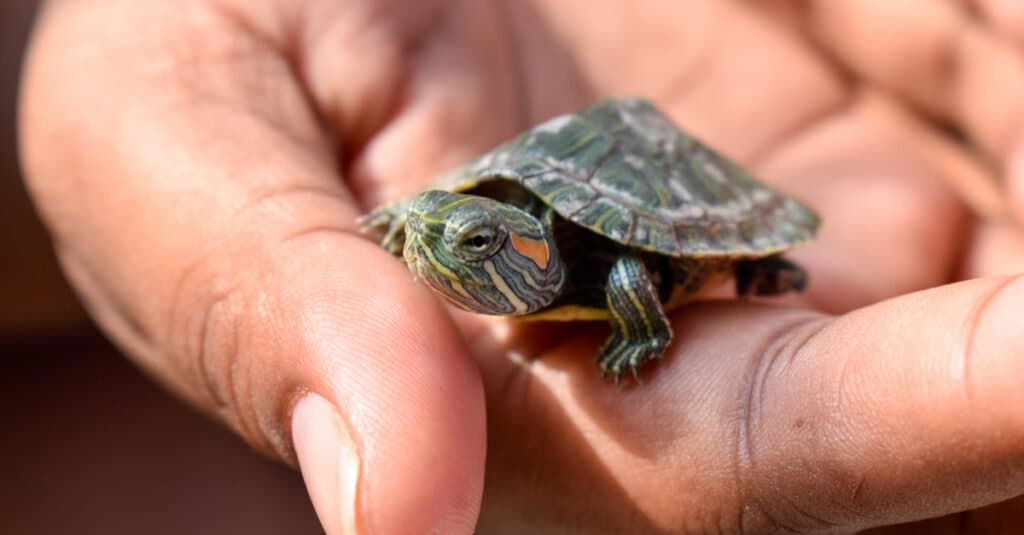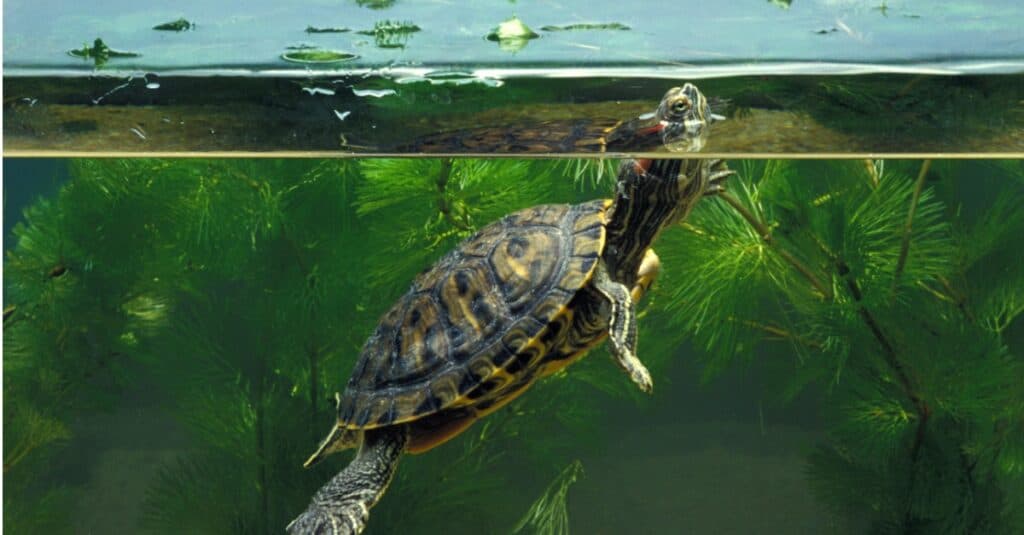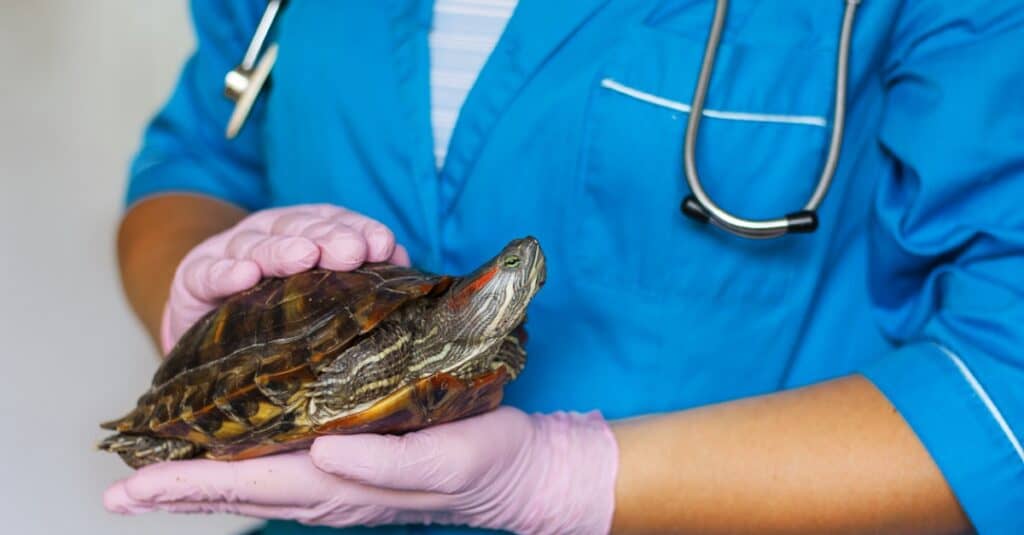What to Feed Juvenile Red Eared Sliders
Adopting a new pet is exciting, especially if you get to bond with them from when they're a baby! Knowing how to care for your baby red-eared slider is essential to their survival early on, as they are very fragile animals in their first year or so of life. Although most of their care needs are the same as those for adult red-eared sliders, baby turtles have a few extra special requirements, like additional vitamin supplements and a mostly animal protein-based diet to facilitate their growth.
Thankfully, this guide will cover everything you need to know to keep your baby red-eared slider healthy! Read on as I cover the basics, like enclosure size and setup, as well as some lesser-known care tips.
What Enclosure is Best For a Baby Red-Eared Slider?

Akash Naik/Shutterstock.com
For baby red-eared sliders, a 30 to 50-gallon tank is sufficient while the turtle is less than 6 inches long. However, keep in mind that sliders grow very quickly and reach their adult size within only a year or two. Many turtles also continue growing well into their adulthood! You'll need a much larger enclosure, or at least 75 to 100 gallons, for a full-sized slider.
You have two options when it comes to enclosure sizes for a baby red-eared slider. Depending on your slider's exact age, they are likely somewhere between 3 and 5 inches long. You could potentially place the baby turtle in a smaller, temporary enclosure until they reach their full size, and then transfer them to a larger tank later. Alternatively, you could simply buy a full-sized enclosure and place your baby slider in it from the start.
There's a common misconception in the reptile hobbyist community that baby reptiles become overwhelmed by very large enclosures. However, this is actually not the case with the vast majority of species, including red-eared sliders! In fact, baby reptiles typically enjoy having extra space to roam around.

I highly recommend going ahead and buying a 75 to 100-gallon enclosure rather than buying a temporary setup and switching later. While it seems like you'll save money early on by buying a less expensive tank, you'll need a larger setup much sooner than you think!
There are a few different enclosure styles on the market that are suitable for red-eared sliders. These include standard rectangular glass aquariums, more elaborate custom builds, and even indoor and outdoor ponds. All are excellent choices, as long as they have plenty of space, adequate warmth and humidity, and lots of clean water.
Setting Up a Baby Red-Eared Slider Habitat

iStock.com/:Marina Vedernikova
Once you've chosen a suitable enclosure, it's time to properly furnish it so it's ready for your new pet. For a baby red-eared slider habitat, you'll need the following supplies:
- Heat/basking lighting
- UVB lighting (5%+ to 10% output is highly recommended)
- Substrate (ideally large, smooth river rocks or gravel)
- Temperature and humidity gauges
- A high-quality water filter
- Minimal decorations (plants, rocks, hides, etc.)
What's great about this particular setup is it's also perfectly suitable for an adult red-eared slider! Most, if not all, of the supplies you'll need to care for a baby red-eared slider are also necessary for an adult's enclosure.
However, the arrangement of your decor, rocks, substrate, and even the water level are particularly important when it comes to baby turtles! Baby sliders are very fragile and can become injured easily by falls or even if their water is too deep, cold, or hot.
Make sure your slider has plenty of access to platforms, shallow areas, and rocks so they can emerge from the water without a struggle while they're still learning to swim. The water's deepest point should only be about twice as deep as the length of your slider's entire body.
As far as temperature and humidity go, babies also mostly require the same settings as adult sliders. An 85F to 95F air temperature, 75F to 85F water temperature, and a humidity level of around 75% is ideal. Having at least one, if not two, temperature and humidity gauges is a good idea to monitor and prevent any significant fluctuations.
Finally, keep the water as clean as possible and check your water filter often. Baby turtles are incredibly susceptible to illnesses while their immune systems are still developing. A clean enclosure free of any harmful bacteria is absolutely essential to your baby red-eared slider's care and overall health.
What Do Baby Red-Eared Sliders Eat?

iStock.com/slowmotiongli
Red-eared sliders are omnivorous, so they prefer to eat a combination of plant and animal matter. However, baby sliders require more animal protein compared to plant matter to facilitate their growth and development early on. They especially enjoy eating the following feeder insects, arthropods, and invertebrates:
- Mealworms
- Earthworms
- Shrimp
- Snails
- Tadpoles
- Crickets
- Small fish
As far as plant matter goes, the following vegetables are all great choices:
- Dark, leafy greens (Collard, turnip, dandelion, mustard, etc.)
- Squash
- Carrots
- Green beans
- Bell peppers
Finally, a small amount of the following fruits are safe as occasional treats:
- Apples
- Strawberries
- Mangoes
- Blueberries
- Bananas
Additionally, baby red-eared sliders must eat more frequently than adults due to their rapid metabolisms at such a young age. While adult turtles only need to eat two or three times a week, babies should eat once per day. Once your turtle is six months old, you can start feeding them less frequently, or about every other day.
A good rule of thumb is to feed your slider as much as they will eat within a 10 to 15-minute period. Keep their food items small, or at least smaller than the width of the space between their eyes. This will minimize the risk of choking and impaction.
It's also a good idea to buy a calcium and vitamin D3 supplement for your slider's meals. These vitamin supplements are beneficial to most reptiles' bone and muscle growth and development. Most supplements for reptiles are powdered so you can easily sprinkle them atop any animal or plant matter.
When Should Your Slider See a Veterinarian?

iStock.com/фотограф
Once you've brought your red-eared slider home and set up their enclosure, they should see a reptile veterinarian as soon as possible. I recommend a check-up at least once a year, though twice a year is even better for baby sliders if you can afford it.
Since baby red-eared sliders are so fragile and prone to illnesses and injuries, seeing a veterinarian at the first sign of trouble is crucial. It's also a good idea to keep at least $500 on hand for potential medical emergencies. But don't just wait until your turtle starts displaying troublesome symptoms to get them veterinary attention! An annual or biannual check-up can help you spot potential illnesses early on before they become severe (and more expensive to treat).
Common health issues include respiratory infections, parasite infestations, and calcium deficiencies. These can all be prevented with a hygienic enclosure setup, a nutritious diet, and correct temperature and humidity settings. Of course, the keen eye and guidance of a reptile veterinarian is also very valuable!
Most importantly, keep a close watch on your pet's day-to-day behavior. Sick reptiles tend to not show their symptoms until their situation becomes dire. This is mostly a self-defense mechanism to prevent themselves from looking weak to potential predators. Even if your slider trusts you, they may still hide their symptoms out of instinct if they become ill.
Thank you for reading! Have some feedback for us? Contact the AZ Animals editorial team.
Source: https://a-z-animals.com/blog/how-to-care-for-a-baby-red-eared-slider/
0 Response to "What to Feed Juvenile Red Eared Sliders"
Post a Comment